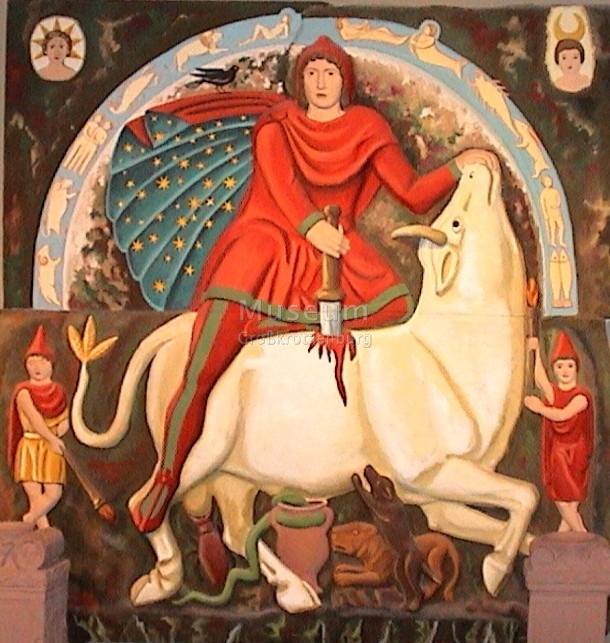" ... the Persians, mystically signifying the descent of the soul into the sublunary regions, and its regression from it, initiate the mystic (or him who is admitted to the arcane sacred rites) in a place which they denominate a cavern. For, as Eubulus says, Zoroaster was the first who consecrated in the neighboring mountains of Persia, a spontaneously produced cave, florid, and having fountains, in honour of Mithras, the maker and father of all things; a cave, according to Zoroaster, bearing a resemblance of the world, which was fabricated by Mithras. But the things contained in the cavern being arranged according to commensurate intervals, were symbols of the mundane elements and climates. 3. After this Zoroaster likewise, it was usual with others to perform the rites pertaining to the mysteries in caverns and dens, whether spontaneously produced, or made by the hands. For as they established temples, groves, and altars to the celestial Gods, but to the terrestrial Gods, and to heroes, altars alone, and to the subterranean divinities pits and cells; so to the world they dedicated caves and dens; as likewise to Nymphs , on account of the water which trickles, or is diffused in caverns, over which the Naiades, as we shall shortly observe, preside. Not only, however, did the ancients make a cavern, as we have said, to be a symbol of the world, or of a generated and sensible nature: but they also assumed it as a symbol of all invisible powers; because as caverns are obscure and dark, so the essence of these powers is occult. ...
" ... honey is assumed ... as an antidote to putrefaction, and is indicative of the pleasure which draws souls downward to generation; it is a symbol well adapted to aquatic Nymphs, on account of the unputrescent nature of the waters over which they preside, their purifying power, and their co-operation with generation. For water co-operates in the work of generation. On this account the bees are said, by the poet, to deposit their honey in bowls and amphorae; the bowls being a symbol of fountains, and therefore a bowl is placed near to Mithras, instead of a fountain; but the amphorae are symbols of the vessels with which we draw water from fountains. ...
" ... Caves, therefore, in the most remote periods of antiquity were consecrated to the Gods, before temples were erected to them. Hence, the Curetes in Crete dedicated a cavern to Jupiter; in Arcadia, a cave was sacred to the Moon, and to Lycean Pan; and in Naxus, to Bacchus. But wherever Mithras was known, they propitiated the God in a cavern. With respect, however, to the Ithacensian cave, Homer was not satisfied with saying that it had two gates, but adds that one of the gates was turned towards the north, but the other which was more divine, to the south. He also says that the northern gate was pervious to descent, but does not indicate whether this was also the case with the southern gate. For of this, he only says, 'It is inaccessible to men, but it is the path of the immortals.' ...
" ... the gates of the Homeric cavern are not dedicated to the east and west, nor to the equinoctial signs, Aries and Libra, but to the north and south, and to those celestial signs which towards the south are most southerly, and, towards the north are most northerly; because this cave was sacred to souls and aquatic nymphs. But these places are adapted to souls descending into generation, and afterwards separating themselves from it. Hence, a place near to the equinoctial circle was assigned to Mithras as an appropriate seat. And on this account he bears the sword of Aries, which is a martial sign. He is likewise carried in the Bull, which is the sign of Venus. For Mithras, as well as the Bull, is the Demiurgus and lord of generation . But he is placed near the equinoctial circle, having the northern parts on his right hand, and the southern on his left. They likewise arranged towards the south the southern hemisphere because it is hot; but the northern hemisphere towards the north, through the coldness of the north wind."

